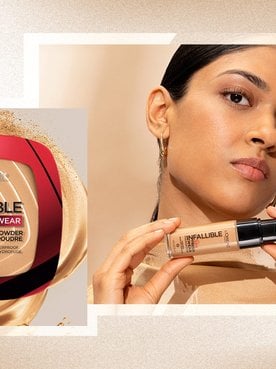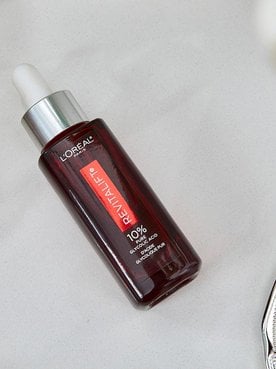In this article
- How To Match Your Foundation Shade
- How Can I Match My Foundation Color Online?
- How To Find Your Perfect L’Oréal Infallible Fresh Wear Foundation Shade
- How Do I Know My Liquid Foundation Shade?
- How Do I Know If a Shade Is Lighter or Darker Than Another?
- How Do I Know My Fresh Wear Foundation in a Powder Shade?
Foundation is one of the few makeup steps where you want skin to look like skin. A smart foundation shade finder routine helps you create an even base that blends into your complexion without visible lines. Keep reading to discover how to find your foundation shade and achieve a natural-looking finish.
Shop the Products
Understanding Skin Tone and Undertones
Identifying skin tone and undertones is the most important step in any foundation color match process. Knowing both helps you narrow options and avoid shades that skew too yellow, pink, or ashy.
What is skin tone?
Skin tone is the color depth of your complexion and typically falls into fair, light, medium, or deep categories. Looking at your clean, makeup‑free face in good natural light usually reveals where you land. Use this as your baseline before trying to figure out how to pick your foundation color.
What are undertones?
Undertones are the underlying color signals that influence how makeup appears once applied. Cool undertones show hints of blue or pink, warm undertones read more golden or yellow, and neutral undertones sit between the two. Recognizing this helps with how to match foundation accurately across different formulas and finishes.
You can use a few quick checks to spot undertones with confidence:
- Look at your veins: Check the inside of your wrist; blue or purple suggests cool, green suggests warm, and a mix often reads neutral.
- Try the paper test: Hold a white sheet near your face; a pink or blue cast signals cool, a yellow cast signals warm, and a grayish cast can indicate neutral.
- Jewelry test: Gold flattering your skin points to warm undertones, silver flattering your skin points to cool, and both working easily points to neutral.
- Sun reaction test: Tanning more easily often aligns with warm undertones, while redness or burning more easily often aligns with cool.
- Take an undertone quiz: Quick guided questions can translate what you see into clear undertone language so you can easily figure out how to select your foundation color.
How To Find Your Foundation Shade
Once you understand undertones, shade matching becomes simpler and more precise. Many bottles label shade families with C, N, or W to signal cool, neutral, or warm. Focus on the family that mirrors your undertone to streamline how to find your foundation shade.
- Test on the right body part: Swipe three adjacent shades on your jawline so you can assess both face and neck for a seamless blend and true foundation color match. If your face and body differ in depth, test on the center of your upper chest to help sync face and neck.
- Look under different lighting: Check the swatches indoors and in daylight because lighting can change how pigments appear on skin.
- Consider the season: Keep a perfect‑match shade for cooler months and a shade one to two steps deeper for summer to maintain continuity without constant repurchasing.
How To Find Your Foundation Match Online
If you've been wondering, "How can I find the right shade of foundation without visiting a counter?", thanks to modern technology, you can actually find what you need with a foundation shade finder online. There are even multiple tools for doing so. Here are a few of your options:
1. Try a virtual foundation finder
Our virtual foundation shade finder is a great way to find your perfect foundation match from the comfort of your own home. It's incredibly easy to use (and only takes 10 seconds). All you have to do is take a 360° selfie video, and your skin tone and undertones will be analyzed based on a library of over 45,000 skin shades. From there, the tool will color-match you to the perfect L’Oréal Paris foundation.
2. Take a foundation shade quiz
If you don’t want to use a camera, try taking the L’Oréal Paris foundation shade finder quiz instead. You’ll answer a few questions about your skin type and foundation preferences, then be shown images of models with different skin tones. After selecting the image that most closely resembles your skin, you’ll be given recommendations for foundations likely to match your skin tone and undertone. All in, it only takes a few minutes to complete the quiz and receive your results.
3. Use a virtual foundation try-on tool
Virtual try-on tools have made shopping for makeup online so much easier. Now, you can get a good idea of how products will look on you without having to visit a store or make a purchase first. For help finding your foundation match, you can also try our virtual makeup try-on tool. Simply upload a selfie or turn on your camera, and you can test-drive different shades of all the L’Oréal Paris foundations. The tool even has a handy before-and-after feature that allows you to see the product's effect on half of your face. That way, you can determine which option best complements your skin tone.
Should Foundation Be Lighter or Darker Than Your Skin?
Aim for a match rather than going lighter or deeper, as this keeps the base invisible on the skin. If your current product appears a bit too light, add warmth with bronzer on the perimeter and subtle contouring through the hollows to rebalance. Going deeper than your skin often looks more obvious than going slightly lighter.
Changing Your Foundation Shade With the Seasons
As the seasons change, so does your skin tone. In summer, increased sun exposure can cause your skin to darken, giving you a warm, sun-kissed glow. In contrast, colder months often lead to lighter, more neutral skin tones, as the sun’s rays are less direct.
To maintain a flawless complexion year-round, consider keeping two foundation colors to match your changing skin tone—one for summer and one for winter. This ensures your makeup always matches your natural skin tone, preventing any mismatch.
How To Choose the Right Foundation Formula
How to find your foundation shade also depends on the right texture. Selecting the right foundation formula depends on your skin type and desired finish. For oily skin, look for matte or oil-free foundations to control shine and provide long-lasting coverage. Those with dry skin tend to benefit from hydrating liquid or serum foundations that deliver moisture and a smooth finish. If you have combination skin, opt for lightweight liquid or cream formulas that balance coverage without making your skin feel too heavy or greasy.
If you love a natural glow, look for skin tints and radiant finishes. If you prefer more coverage, opt for buildable formulas that remain thin on the skin to avoid a heavy look.
Our Best Foundations for Every Skin Tone
Once you have your match, choose a formula that suits your finish goals and daily wear needs. The options below include breathable tints, flexible liquids, and long‑wear bases for different preferences and routines.
L’Oréal Paris Lumi Le Glow Skin Tint
This lightweight, water‑based tint contains reflective pearls and blurring pigments for breathable coverage with a second‑skin glow. The 82% hydrating serum base helps cushion dry areas, so skin looks fresh rather than heavy. Use fingers or a damp sponge for a soft veil that enhances your foundation color match without masking texture.

L’Oréal Paris True Match Super-Blendable Foundation
This buildable classic blends seamlessly and supports a natural finish that reads like skin. The range organizes shades by warm, cool, and neutral families to simplify how to match foundation across undertones. The L'Oréal True Match Foundation offers extensive options to dial in a precise match.
L’Oréal Paris Infallible 32 Hour Fresh Wear Foundation
This ultra‑thin liquid delivers lightweight, medium‑to‑full coverage that resists sweat and wear. Up to 32 hours of performance helps makeup stay even from day to night in varied conditions. Apply in thin layers and spot-build where needed to preserve a natural foundation color match.

Shop the Products
L’Oréal Paris True Match Hyaluronic Tinted Serum
This serum‑like base offers a lightweight feel with flexible, easy‑to‑blend coverage. The finish boosts radiance, which helps skin look fresh and well‑rested. Pair it with a pinpoint concealer such as the L'Oréal Paris Infallible Full Wear Concealer Up To 24H Full Coverage to keep the overall effect sheer.

L’Oréal Paris Infallible Up to 24H Fresh Wear in a Powder
Powder foundations are great for achieving a flawless, airbrushed look. This breathable and weightless formula stays put for up to 24 hours and offers a soft matte finish that’s comfortable and suitable for all skin types, including acne-prone skin. The best part? It’s waterproof and sweatproof, so you won’t have to worry about touch-ups throughout the day.

Shop the Products
Common Foundation Matching Mistakes to Avoid
Even polished routines can stumble on the basics, and shade matching is no exception. Scan this list before swatching or using a foundation shade finder to ensure a seamless match and a base that looks like skin.
- Testing on the wrong area: Swatching on the hand or forearm often leads to a mismatch because those areas differ from the face and neck.
- Ignoring undertones: Skipping undertone checks makes shades read too yellow, too pink, or ashy once blended.
- Using poor lighting: Evaluating only under fluorescent or dim light changes how pigments appear compared with natural daylight.
- Not waiting for oxidation: Some formulas settle and deepen slightly after a few minutes, so reassess before deciding.
- Skipping primer or prep: A smooth, hydrated base helps formulas spread evenly and keeps your foundation color match consistent.
Next Up: The Best Blush for Mature Skin: How to Choose the Perfect Formula
Photo courtesy of L’Oréal Paris







